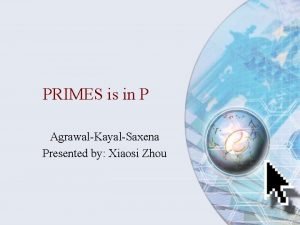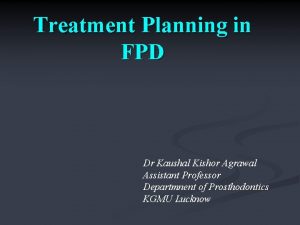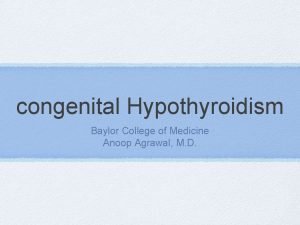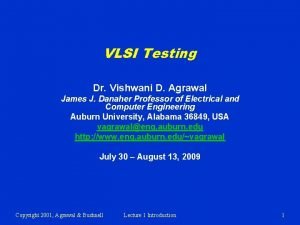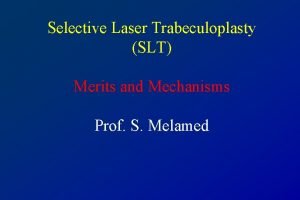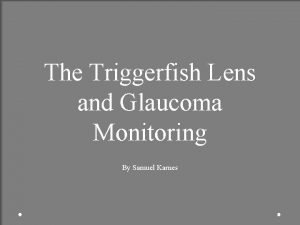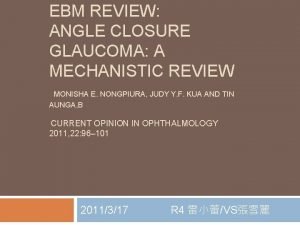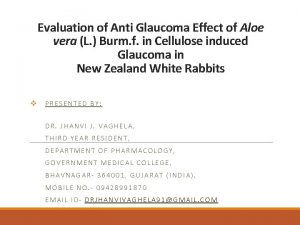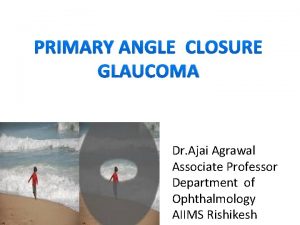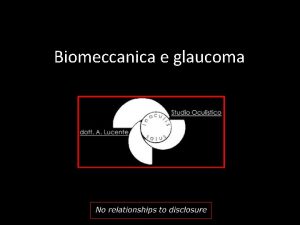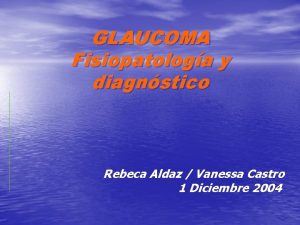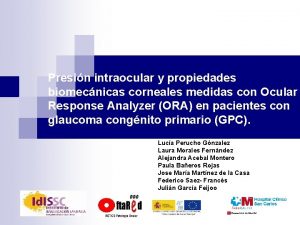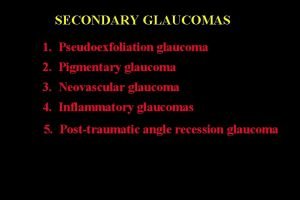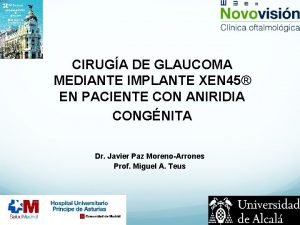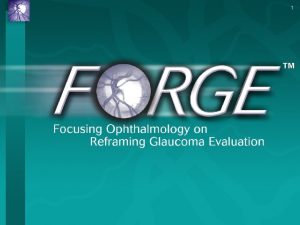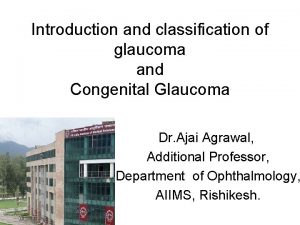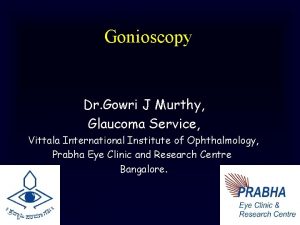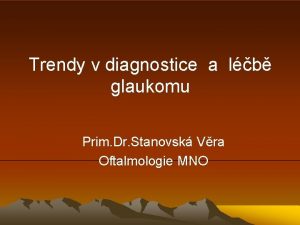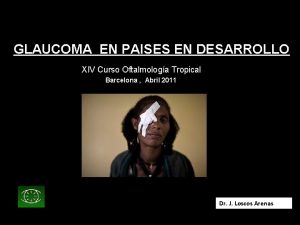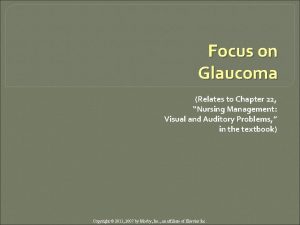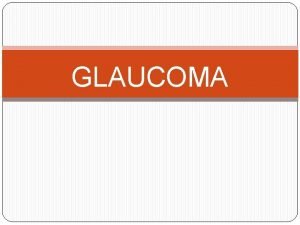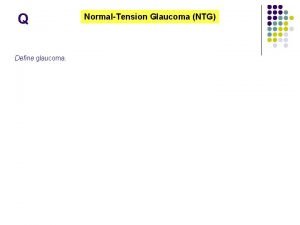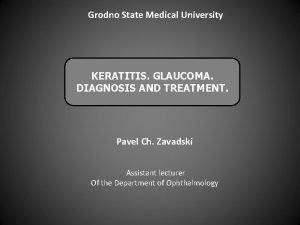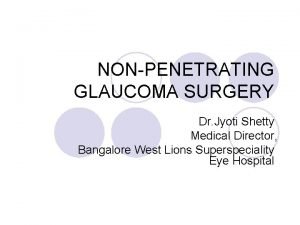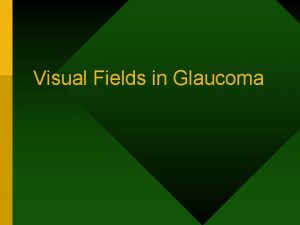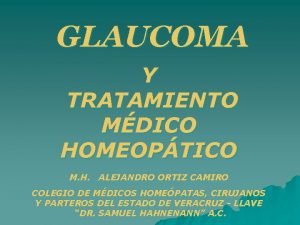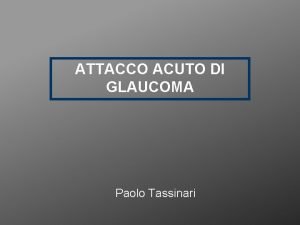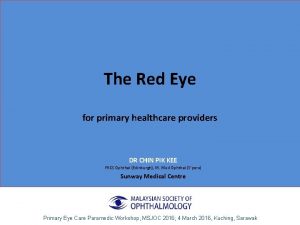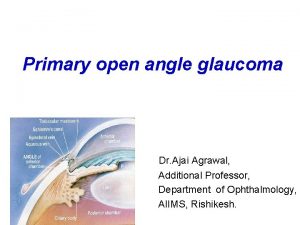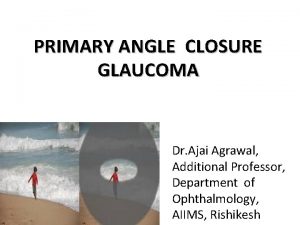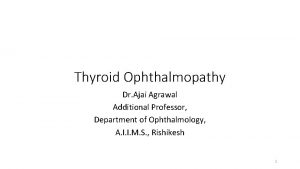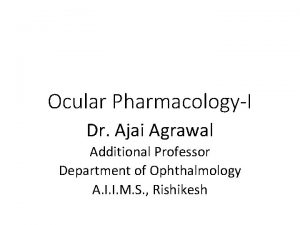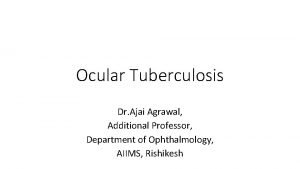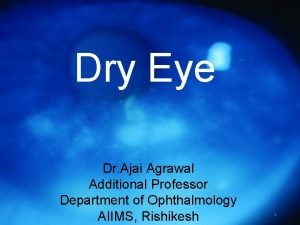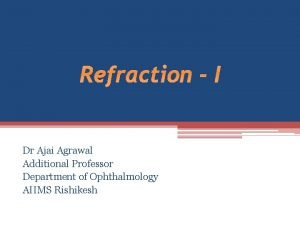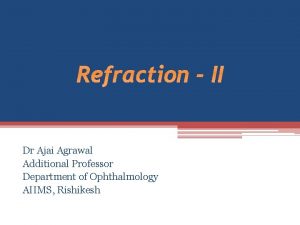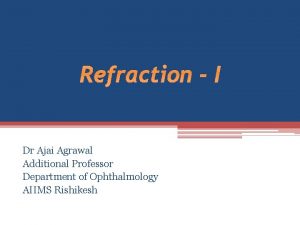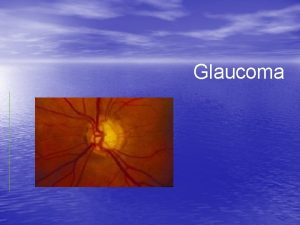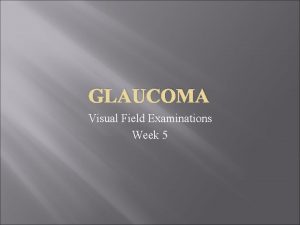Secondary Glaucoma Dr Ajai Agrawal Additional Professor Department














































- Slides: 46

Secondary Glaucoma Dr. Ajai Agrawal Additional Professor, Department of Ophthalmology, AIIMS, Rishikesh

Acknowledgement • Kanski’s Clinical Ophthalmology (8 th Edition). • Becker- Schaffer’s Diagnosis and therapy of The Glaucomas (8 th Edition). • Comprehensive Ophthalmology (A. K. Khurana) (7 th Edition). • Glaucoma - Medical Diagnosis & Therapy (Tarek M Shaarawy )(2 nd Edition). 2

Learning Objectives • At the end of this class the students shall be able to : • Define secondary glaucoma. • Classify secondary glaucoma. • Understand the aetiopathogenesis and clinical features of secondary glaucoma’s. • Understand the fundamentals of managing secondary glaucoma’s. 3

Question • A 12 year old boy is diagnosed as having an angle recession glaucoma. It is a type of • • primary open angle glaucoma secondary open angle glaucoma primary angle closure glaucoma secondary angle closure glaucoma 4

Definition • Secondary Glaucoma A group of disorders in which rise in intraocular pressure(leading to glaucoma) is associated with some primary ocular or systemic disease. 5

Classification of secondary glaucoma's • Based on mechanism of IOP rise Secondary open angle glaucoma Secondary angle closure glaucoma 6

Classification of secondary glaucoma's • Depending on causative primary disease – Phacogenic (Lens induced) glaucoma – Pigmentary glaucoma – Neovascular glaucoma – Inflammatory glaucoma (Uveitic) – Traumatic glaucoma – Steroid induced glaucoma – Pseudoexfoliative glaucoma – Glaucomas associated with intraocular tumours (Malignant melanoma, retinoblastoma) 7

8

9

Lens induced glaucoma • Raised IOP secondary to a disorder of crystalline lens • Secondary angle closure Secondary open angle Phacomorphic glaucoma Phacolytic glaucoma Phacotopic glaucoma Lens particle glaucoma Phacoanaphylactic glaucoma 10

Phacomorphic glaucoma • Causes • Intumescent lens • Anterior subluxation or dislocation of the lens and spherophakia (Phacotopic variant) • Pathogenesis – Swollen lens pushes iris forwards, obliterating the angle • Presentation – Acute congestive glaucoma 11

Phacomorphic glaucoma • Treatment – • Medical treatment – Control of IOP by iv mannitol, systemic acetazolamide and topical beta blockers • Surgical Cataract extraction with implantation of PCIOL 12

Phacolytic glaucoma • Trabecular meshwork is clogged by lens proteins and macrophages which phagocytose the lens proteins and inflammatory debris • Treatment • Medical therapy to lower IOP followed by extraction of cataractous lens with PCIOL implantation. 13

Lens particle glaucoma • Trabecular meshwork is blocked by lens particles floating in aqueous humour. • Management • Medical therapy to lower IOP and irrigation – aspiration of lens particles from anterior chamber 14

Phacoanaphylactic glaucoma • Fulminating acute inflammatory reaction due to antigen – antibody reaction • Granulomatous inflammation in involved eye • Preceding disruption of lens capsule and leakage of proteins from capsule • IOP is raised due to inflammatory reaction of uveal tissue excited by lens matter. 15

Phacoanaphylactic glaucoma • Management includes medical therapy to lower IOP. Treatment of iridocyclitis with steroids and cycloplegics. Irrigation – aspiration of lens matter from anterior chamber ( if required). 16

Pigmentary glaucoma • Clogging up of trabecular meshwork by pigment particles in patients with Pigment Dispersion Syndrome(PDS) • Pigment released by mechanical rubbing of posterior pigment layer of iris with zonular fibrils • Clinical features – • Young myopic males • Features similar to POAG • Deposition of pigment granules in anterior segment Pigment deposition on lens zonules and equatorial region. The deposits are clearly visible in full mydriasis. 17

REVERSE PUPILLARY BLOCK IN PIGMENTARY GLAUCOMA 18

CLASSIC DIAGNOSTIC TRIAD • Krukenberg spindle (Pigment deposition on the endothelium, in a vertical spindle-shaped distribution). • Midperipheral iris transillumination defects • Dense trabecular meshwork pigmentation 19

Pigmentary glaucoma • Gonioscopy – pigment accumulation along the Schwalbe’s line especially inferiorly (Sampaolesi’s line) • Iris transillumination – radial slit – like defects in the periphery • Treatment is similar to that of POAG 20

Neovascular glaucoma • Intractable glaucoma due to neovascularisation of iris and angle of anterior chamber. • Due to retinal ischaemia Diabetic retinopathy CRVO Sickle cell retinopathy Eales’ disease Chronic intraocular inflammation 21

PATHOGENESIS • CHRONIC RETINAL ISCHAEMIA • ANGIOGENIC FACTORS RELEASED • NEOVASCULARISATION ON IRIS AND ANGLE • NEOVASCULAR GLAUCOMA 22

Stages of neovascular glaucoma • Pre-glaucomatous stage • Open angle glaucoma stage • Secondary angle closure glaucoma 23

TREATMENT • Panretinal photocoagulation • Intra- vitreal Anti -VEGF • Mydriatics and Corticosteroids • Filtering surgeries • Glaucoma drainage devices • Cyclodestructive procedures 24

INFLAMMATORY GLAUCOMA • Non specific inflammatory glaucoma • Open angle • Angle closure • Specific hypertensive uveitis syndromes • Fuchs’ uveitis syndrome • Glaucomatocyclitic crisis (Posner Schlossman syndrome) 25

26

Open angle inflammatory glaucoma Acute open – angle Chronic open – angle inflammatory glaucoma Mechanism of rise in IOP Trabecular clogging , trabecular oedema and prostaglandin – induced rise in IOP Chronic trabeculitis and trabecular scarring Clinical features Features of acute iridocyclitis associated with raised IOP with open-angle of anterior chamber Raised IOP, open angle, no active inflammation but signs of previous episode of uveitis present Management Treatment of iridocyclitis Medical therapy to lower IOP by use of hyperosmotic agents, acetazolamide and beta – blockers eye drops Medical therapy Trabeculectomy Cyclodestructive procedures 27

Angle closure inflammatory glaucoma Mechanism of rise in IOP – Secondary angle – closure with pupillary block Secondary angle – closure without pupillary block Clinical features – Raised IOP, seclusio papillae, shallow anterior chamber • Management – • Prophylaxis – Local steroids and atropine to prevent formation of synechiae • Curative treatment – Medical therapy, surgical or laser iridotomy and filtration surgery • • 28

Specific hypertensive uveitis syndromes • Glaucomatocyclitic crisis (Posner Schlossman syndrome) • Recurrent attacks of unilateral, acute mild uveitis with secondary open angle glaucoma. • Glaucoma is out of proportion to inflammation. • Due to accompanying acute trabeculitis. • Fuchs’ uveitis syndrome • Chronic low grade anterior uveitis. • Occurs unilaterally in middle aged persons • Heterochromia of iris • No posterior synechia. • Associated with cataract and secondary glaucoma 29

Blunt Trauma 30

31

Causes of glaucoma after trauma • • • Inflammatory glaucoma Glaucoma due to hyphema Lens induced glaucoma Angle recession glaucoma Epithelial or fibrous ingrowth Angle closure due to PAS 32

Angle recession glaucoma • Rupture in ciliary body face • Bimodal onset at 1 year and 10 year post trauma • 270 degree recessionrisk of glaucoma- 5% • 360 degree recessionrisk of glaucoma- 24% Gonioscopic view of angle recession, demonstrated by a widened ciliary body band. There is a disruption in the ciliary body between the external longitudinal muscle fibers and the internal oblique and circular 33 muscle fibers.

Traumatic glaucoma • Management • Medical therapy with topical 0. 5% timolol and oral acetazolamide • Surgical intervention needs to be individualized according to nature and site of trauma 34

Steroid induced glaucoma Secondary open angle glaucoma following steroid therapy In the general population: High steroid responders – 5% Moderate steroid responders – 35% Non steroid responders – 60% (IOP rise after six weeks of steroid therapy) Precise mechanism of IOP rise not known Prevented by judicious use of steroids and regular IOP monitoring Treated by stopping steroids gradually and anti glaucoma medications • • • 35

Pseudoexfoliative glaucoma • Pseudo exfoliation syndrome(PES)/Glaucoma capsulare is associated with Secondary OAG in 50% of the cases. • Deposition of an amorphous grey dandruff – like material on the pupillary border, posterior surface of iris and ciliary processes • Trabecular blockage by exfoliative material • Managed on the same lines as POAG 36

Causes of elevated IOP post cataract surgery • • Early phase Inflammation Haemorrhage Retained viscoelastic/lens matter • • • Late phase Tight suture Excessive cautery Pupillary block(IOL/Vitreous) Aqueous misdirection Epithelial/Fibrous down growth 37

Glaucoma associated with iridocorneal endothelial syndromes • • Three clinical entities: Progressive iris atrophy Chandler’s syndrome Cogan-Reese syndrome/Iris nevus syndrome • Pathogenesis: Abnormal corneal endothelial cells proliferate to form a membrane in angle of AC. Contraction of membrane leads to secondary angle closure • Treatment: Difficult and usually surgical 38

Other causes of secondary glaucoma • Glaucoma in aphakia/pseudophakia • Ciliary block glaucoma • Glaucoma associated with intraocular haemorrhage Red cell glaucoma Haemolytic glaucoma Ghost cell glaucoma Hemosiderotic glaucoma 39

40

41

42

Question • A 50 year old lady with uncontrolled diabetes presented with painful red eye and decreased visual acuity in her right eye. On examination there was raised Intraocular Pressure and new blood vessels on the iris. The treatment includes all except? • atropine • beta blockers • steroids • pilocarpine 43

Question • The laser procedure, most often used for treating neovascular glaucoma: a) Goniophotocoagulation b) Laser trabeculoplasty c) Panretinal photocoagulation (PRP) d) Laser iridoplasty 44

Question • What is the most likely type of glaucoma in this patient ? a) Phacolytic glaucoma b) Phacoanaphylactic glaucoma c) Phacotopic glaucoma d) Lens particle glaucoma 45

46
 Ajai nair
Ajai nair Promotion from assistant to associate professor
Promotion from assistant to associate professor Asptro
Asptro Dr deepak agrawal
Dr deepak agrawal Dr raj agrawal
Dr raj agrawal Ameeta agrawal
Ameeta agrawal Agrawal-kayal-saxena
Agrawal-kayal-saxena Krati agrawal
Krati agrawal Biomedical waste definition
Biomedical waste definition Crown root ratio
Crown root ratio Shankarlal agrawal science college salekasa
Shankarlal agrawal science college salekasa Divyakant agrawal
Divyakant agrawal Subodh agrawal
Subodh agrawal Anoop agrawal
Anoop agrawal Ca rakesh agrawal
Ca rakesh agrawal Shweta agarwal iit madras
Shweta agarwal iit madras Vishwani agrawal
Vishwani agrawal Iris nodules uveitis
Iris nodules uveitis M
M Triggerfish glaucoma
Triggerfish glaucoma Primary angle closure glaucoma
Primary angle closure glaucoma Is aloe vera good for glaucoma
Is aloe vera good for glaucoma Gonioscopy grading
Gonioscopy grading Springbank glaucoma
Springbank glaucoma Glaucoma phacomorphic
Glaucoma phacomorphic Dra vanessa castro
Dra vanessa castro Nursing diagnosis of cataract
Nursing diagnosis of cataract Acute glucoma
Acute glucoma Triggerfish glaucoma
Triggerfish glaucoma Glaucoma congenito
Glaucoma congenito Pseudoexfoliation glaucoma
Pseudoexfoliation glaucoma Implante xen
Implante xen Isnt rule
Isnt rule Stumped corneal opacity
Stumped corneal opacity Define gonioscopy
Define gonioscopy Pex glaucoma
Pex glaucoma Ciclodiodo
Ciclodiodo Preoperative nursing management of glaucoma
Preoperative nursing management of glaucoma Bayoneting vessels glaucoma
Bayoneting vessels glaucoma Scheie stripe
Scheie stripe Congenital glaucoma
Congenital glaucoma Fornix based conjunctival flap
Fornix based conjunctival flap Baring of blind spot in glaucoma
Baring of blind spot in glaucoma Glaucoma angulo abierto vs cerrado
Glaucoma angulo abierto vs cerrado Angolo di van herick
Angolo di van herick Circumcorneal flush
Circumcorneal flush Glaucoma continuum
Glaucoma continuum






